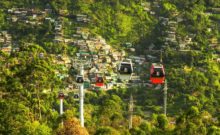Colombia has had many beneficial international publicity since 2007, five years after former president Alvaro Uribe’s administration, who went to great lengths to ensure urban safety concerns that had been that bane of Colombia’s existence during the 80’s and the 90’s.
As a matter of fact, since 2002, real estate prices soared everywhere in the nation. Just that year alone they jumped up to 20 or 25%. From 2003 to 2007 many regions in Colombia saw annual gains along the lines of 10 to 15%. During the global recession, during which many countries from the western world were experiencing real estate prices sinking at the tune of 30 to 50%, Colombia basically remained status quo. Part of Colombia’s coming out relatively unscathed was due to the fact that it had been hiding from international economy for so many years.
In Medellin, for example, there was basically a side market from 2007 to 2009. Sales stayed normal for a bit and did not really move upwards or downwards at this point. But then 2010 saw a price spike of 5.8% followed by 6.2% in 2011 and 5.9 in 2012. This is by no means an occurrence exclusive to Medellin.
So is there an impending real estate bubble in Medellin?
This is one of the questions that people ask the most around Medellin, since there is a lot of pre-construction high rise development right now, everywhere in the city, particularly in Medellin’s version of Beverly Hills, El Poblado. More often than not, people visiting ask “how is it possible to continue building up this inventory? It can’t possibly sustain itself so prices have to collapse”.
Here are some of the reasons why many experts believe that not only is there no bubble in Colombia, but that right now is the absolute best time to buy real estate, especially in Medellin:
- Real estate bubbles have a number of characteristics some measured by numerous financial indicators such as price to income ratio, affordability index, deposit to income, housing debt to income, etc. For Medellin, and I feel many parts of Colombia, we are seeing a reduction in poverty levels and an emerging middle class. Thus more people can afford homes and demand is going up.
- Plus wages are pegged to the annual inflation rate which from 2002-2008 ranged from 4-8% and from 2009-2012 ranged from 3-4%. Thus more than 50% of each year’s price increases in real estate are offset by higher annual wages that are pegged to the national inflation rate. So there are no signs of runaway price increases by this measure.
- The five characteristics of a real estate bubble are displacement, boom, euphoria, profit taking and panic. Colombia is just now moving into the boom phase. It has many phases left to go before the bubble occurs.
And again the “wild card” – what happens when the world wakes up and learns the truth about this great country and why it is wise to invest here and own assets denominated in Colombian pesos and not declining U.S. dollars?
Some experts, based on the reasons above and many others, believe that the “impending Colombian bubble of doom” is nonsense. Demand for real estate that surpasses the ability for inventories to meet the demand actually seems likely to grow, given that the country has a strong emerging economy, a top-performing stock market, Foreign Direct Investment growing to the tune of 20 to 30%, exporting gold, silver, oil, gas, coal, hydro-electrical power and important agricultural commodities, an yearly GDP increase of 4-6%, a low inflation rate and an expanding middle class.
Stop wasting time and invest now
But all of that aside, ask yourself this: What will happen when the world catches word of this amazing country and why it is wise to invest there and own assets valued in Colombian pesos instead of U.S. dollars?If you’re looking to buy a home or an investment property in Colombia, feel free to contact us today.













